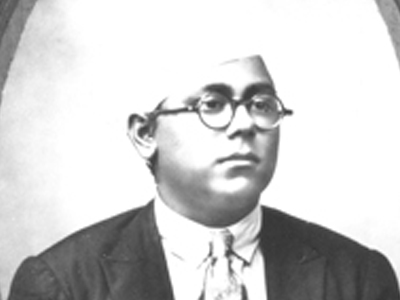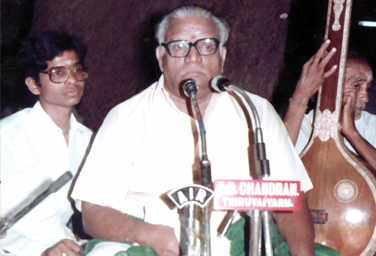SPECIAL FEATURE
S.G. KITTAPPA - Gandharva of the Tamil stage
VAMANAN

He was acknowledged as the Nataka Chakravarti or Emperor of the Stage in an era when music was king, queen and courtier. His dramatic singing was recognised as the high point of the musical values of the Tamil theatrical renaissance. Such was the power of his song that even the common man developed an ear for classical music. His on-stage and off-stage romance with his adoring partner, the inimitable K.B. Sundarambal, set a million hearts aflame in the Tamil-speaking world – from Madurai and Kumbakonam to Colombo, Rangoon and Singapore. His sudden and meteoric passing made her don sackcloth and ashes with the pledge that she would act with no other male partner, a pledge that she kept for the next half century of her life.
S.G. Kittappa has been all but forgotten by the Establishment down the decades. His birth centenary in 2006 did not as much as excite a whisper, in contrast to the way Maharashtra celebrated the centenary of Bal Gandharva, the doyen of its theatre, in 1987. Kittappa, ‘lion of Shencottah’ is an almost forgotten man even in his home town. Had he not got over his antipathy to the gramophone in the last few years of his life and recorded some sixty songs, and had his friend and admirer, the freedom-fighter and Gandhian, Aakkoor Ananthachari not recorded the highlights of his career, the life and exploits of this vocal Pied Piper might have been the stuff of old wives’ tales.
by VAMANAN
THEATRE
Tamil theatre: a lost legacy
V. RAMNARAYAN

Na. Muthuswami’s pathbreaking work, with his Koothu-p-pattarai a fertile training ground for Tamil actors, is an oasis in the desert of Chennai’s serious theatre scene. In the mainstream, not even a handful of amateur theatre groups offer more than fluffy comedies. And unlike the vibrant atmosphere in the English theatre world of Chennai, albeit often of dubious quality, its Tamil counterpart does not enjoy much audience support.
Things were much better for the stage industry in the last century. While entertainment (other than films) in the Chennai of the 1950s and sixties consisted mainly of Carnatic music, the city also offered a monthly dose of amateur theatre. If your earliest ideas of classical music were fashioned by the voices and instruments of the stalwarts of the day – Ariyakudi, Semmangudi, Madurai Mani, Maharajapuram, GNB, MS, MLV, Pattammal, Palghat Mani, Lalgudi, Krishnan and many more – Tamil drama offered considerable variety too.
ART-STAMPS
Kalki Krishnamurti: Patriot, writer and art critic
By S. SANKARANARAYANAN

The name of Kalki Krishnamurti occupies an eminent place in the annals of Tamil literature and journalism. A trendsetter in racy Tamil prose, his vast literary output included all categories of literature, except drama. He also raised the status of Tamil journalism. He was a connoisseur of performing arts. His critiques of music and dance recitals appeared in Ananda Vikatan, and later in Kalki, from 1931. His reports were unbiased and humorous and were eagerly anticipated by music lovers.
Stamp on Krishnamurti
A commemorative postage stamp was issued on Krishnamurti on 9 September 1999 to mark his birth centenary. It is in the denomination of 3oo (Rs 3), perf. 13, and was printed on imported un-watermarked adhesive gravure coated stamp paper in photogravure process at India Security Press, Nashik. The line drawing of a book and a quill pen on the cancellation signifies the writer in him.
MY GURU
Maharajapuram Santhanam
By Dr. R. GANESH

I was learning Carnatic music while studying in the IX Standard at the Kalyanasundaram Hr. Sec. School in Tanjavur. One day when I went to visit my friend Giri, I heard melodious music which went straight to my heart. The voice had a magnetic quality and it lingered even after I returned home. The next day Giri’s mother played the music again for me – it was Muthuswami Dikshitar’s Nandagopala in Yamunakalyani sung by Maharajapuram Santhanam. From that moment he became my idol.
My father had this habit of presenting gifts to me and my sisters for securing high marks in the school exams. While my sisters liked ornaments, I opted for cassettes of Maharajapuram Santhanam and was thrilled to receive AVM’s new release. Playing his music countless times, I started collecting more and more of his recordings and became addicted to his masterly renditions. In school I sang his songs at every opportunity and won many prizes. By this time I was determined to become his disciple. My father M. Radhakrishnan, an ardent rasika of Carnatic music, told me it was a Utopian dream to want to learn from such a famous personality. However, he made it a point to take me to Santhanam Sir’s concerts in Chennai and Tiruvaiyaru.


